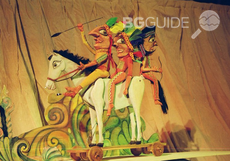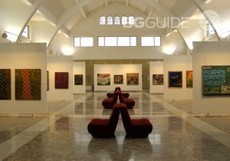State Puppet Theatre – Stara Zagora
State Puppet Theatre - Stara Zagora has a historically distinctive policy and aesthetic taste.
Seven cities and dozens of villages dwell on the lands of the ancients
The Stara Zagora plain covers parts of the former lands of the Thracians - today's eastern half of the Upper Thracian Valley. Seven cities and dozens of villages nowadays dwell on the land of the ancients. In addition to archaeological findings, the affluent area has plenty of mineral springs, rare tree species, and breath taking rose plantations. The oldest tree in Bulgaria – the 1640 “Granitski oak” is located in the village of Granite. The natural landmarks are complemented by the "Sokolna" and "Kamenitsa" Reserves, various protected areas, rock formations, waterfalls and mysterious caves.
In these lands, one of the oldest cities in Europe still exists - Stara Zagora. Back in the Stone Age - 7- 6th century BC., settlers appreciated the favorable conditions in the area. The Bereketska mound, the Azmashka mound and the mound at the Regional Hospital take us thousands of years back in time. The best preserved Neolithic dwellings in Europe are displayed at the latter. In the “Mechi kladenets” area /the Bear’s well/ the oldest copper mines in Europe have been excavated - dated to the 5th c. BC.
The outstanding history of Stara Zagora can be traced back by the numerous names of the city over the ages. The Ancient Thracian settlement from the 4th century BC was known as “Beroe”. The Roman city, dated back to the beginning of the 2nd century AD was called “Augusta Trayana”- the second largest settlement in the Province of Thrace after Philippopolis (Plovdiv). Vereya, Irinopolis, Boruy have all consecutively been its medieval names. It was named “Eski Zagra” by the Ottomans after their invasion in 1364. In the 1850s, the city was renamed “Zheleznik” and as “Stara Zagora” the city’s known since 1871.
Its rich history determines the existence of a large number of places to visit here - a variety of museums and festivals. The "Neolithic dwelling” Museum is located on a large mound and displays the aforementioned Neolithic dwellings. The ancient Forum of Augusta Trayana - center of socio-political and spiritual life has a number of preserved construction facilities. The list is complemented by Augusta Trayana’s South Gate; the Public Building and the Residence with the mosaics from the late Antiquity ; the Hilendarski convent – where Bulgarian Renaissance leaders absconded, at the time of the fight against the Ottoman reign.
The millennial history of Stara Zagora is complemented by its present name - The city of poets and artists, straight streets and lime-trees.
But history isn’t confined within the city limits, it dominates the entire plain. A tour through the neighboring settlements could offer a bit more detailed picture of the turbulent past of these lands. The first modern history museum in Bulgaria is in Dimitrovgrad. There you can see artifacts from the Neolithic period to modern times. There‘s also a unique hall "The youth brigade movement in Bulgaria", reflecting the controversial period of communism. Perhaps the most interesting finding is the skeleton of a Neolithic man, discovered near the village of Krum. Karanovska and Dyadovsko mounds are situated at the municipality of Nova Zagora. The Historical Museum is celebrated for the unique exhibition of restored Thracian chariots. Various sites: burial mounds, several necropolis, open settlements and mounds, fortresses, castles and basilicas are governed by the Archaeological Museum of Radnevo . Apart from a number of accessories, jewelry and tools dated to the Antiquity, the Middle Ages and almost to present days; gold and silver ornaments from the Early Bronze Age, without a derivative on the territory of Bulgaria are stored here as well. The town of Chirpan is known to have succeeded an ancient Roman settlement. The archaeological site of "Karasura" and the "St. Athanasius “Monastery are also situated in the region. The Monastery is supposed to be the oldest Christian center in the Bulgarian lands.

State Puppet Theatre - Stara Zagora has a historically distinctive policy and aesthetic taste.

The theatre in Stara Zagora is more than 130 years old.

Zodiak Gallery is Stara Zagora’s first private gallery.

Palitra Art Gallery exhibits original works by artist Lenko Enchev.

Stara Zagora’s Art Gallery owns over 4000 works.